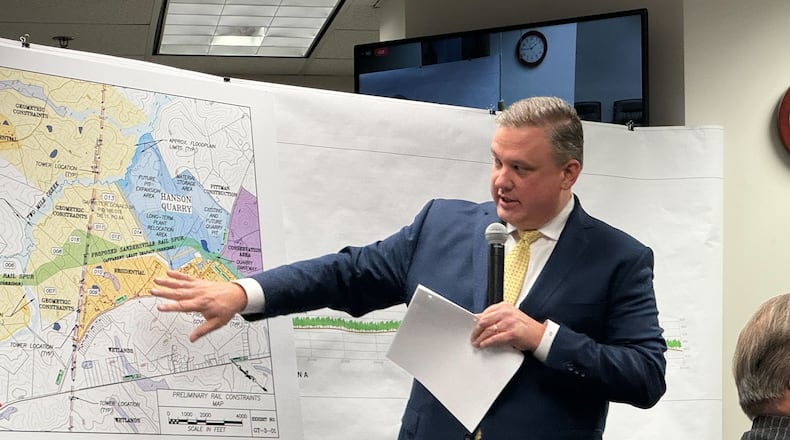Does a Georgia railroad company’s plan to build a spur to serve private businesses qualify as a “public use,” allowing it to force property owners in its path to sell their land?
That question is at the heart of a controversial eminent domain fight that has rocked a small, mostly Black east Georgia town. The outcome could create ripples far beyond the rural confines of Hancock County, one of the state’s poorest.
The case — laid out over four emotional days of hearings at the Georgia Public Service Commission — concerns a plan by the Sandersville Railroad Company to build a 4.5-mile line near the town of Sparta. The proposed Hanson Spur would connect a nearby rock quarry to an existing CSX Transportation line, and might be used by other local businesses to ship grain, liquid asphalt and more.
Backers say it will also allow a quarry to expand, creating jobs and opportunity.
Many of the Sparta residents whose properties the railroad is seeking to acquire have deep ties to their land, some dating back to before the Civil War.
Blaine Smith, a retired Air Force veteran, owns three parcels in the path of the proposed spur, land that has been in his family for more than a century. Before his grandfather bought the property in the 1920s, the land was part of a cotton plantation, where his great-grandmother was born a slave.
Credit: Jason.Getz@ajc.com
Credit: Jason.Getz@ajc.com
Smith has rejected the railroad’s offers to buy his land. He and members of his extended family, who also own land nearby, were among those who testified against the proposed condemnations, saying the project will only benefit a few select businesses, at the expense of their family’s heritage.
“I always remember that my grandparents and parents fought hard to get this property and to keep this property beautiful, productive, clean and whole,” Smith testified on Wednesday. “We should be allowed to give it our own children in the same way.”
Eminent domain is when a government or utility forces a private property owner to sell some — or all — of their land for a specific project. The Fifth Amendment to the U.S. Constitution protects against abuse of eminent domain and requires “just compensation” for seized property. As a public utility, railroads have the authority to invoke it. To exert that power, however, Georgia law requires a court’s determination that a project serves a public use.
In this case, a PSC officer who heard the case will make a recommendation to the commission’s five elected members, who are expected to vote on the railroad’s petition early next year.
An economic boost?
Sandersville Railroad President Benjamin Tarbutton III, and its attorneys, contend the Hanson Spur meets the public use threshold.
Tarbutton’s family has owned Sandersville Railroad for more than 100 years, and he is a former chairman of the Georgia Chamber of Commerce and past chair of the University System of Georgia’s Board of Regents.
“The Hanson Spur will provide new channels of trade for our customers and the region and is necessary to properly accommodate our business, which already serves a public purpose,” Tarbutton testified.
Cale Veal, an executive with Veal Farms Transload and Revive Milling in Washington County, is among those who said he plans to use the spur. He said the link will help him enter major markets that are uneconomical to reach today.
In the hearings and in public outreach, Sandersville Railroad called the Hanson Spur an economic boon. Located roughly 85 miles southeast of downtown Atlanta, Hancock County has ranked among Georgia’s poorest for decades.
Hancock’s median household income is about half the statewide average, and more than 30% of the county’s population lives below the poverty line. While Georgia’s population has grown in recent years, Hancock has lost more than a tenth of its population since 2010.
In an interview, Tarbutton said the spur combined with a planned expansion of the Hanson Quarry by its owner, German multinational Heidelberg Materials, would be “the single-largest private investment in the county ever.”
The railroad says the spur will boost tax revenues, pump $1.5 million annually into the local economy and create 12 new jobs with average salaries of $90,000.
“The ripple effect from the jobs and the multiplier effect is going to be really large,” Tarbutton said.
Community concerns
Neighbors are skeptical.
Janet Smith leads the No Railroad in Our Community Coalition, which intervened in the case and is represented by the Southern Poverty Law Center. Smith said she and other longtime residents have not felt the benefit of nearby industry — two rock quarries, an asphalt plant and the existing CSX line.
“If anything, we’re in worse shape than we’ve ever been,” she said. “So how does (Sandersville) figure another train is going to help us?”
They also fear that the spur will devalue properties, bring unbearable noise and create safety issues for many who use their land to hunt and fish.
Credit: Jason Allen
Credit: Jason Allen
Tarbutton said those concerns are overblown.
He testified that the train will run one round-trip per day on weekdays, only during daylight hours. It will travel less than 20 miles per hour and haul only rocks, wood chips, liquid asphalt and agriculture products, with no plans to move hazardous materials, he said. Tarbutton and others also claim it will reduce heavy truck traffic and benefit the environment.
“Whether they’re using their property for recreation or to harvest timber ... everything they’re doing, they’re going to be able to keep doing,” Tarbutton said, adding that at-grade crossings will be built along the spur.
Public use debate
The PSC’s ruling in the case will be closely watched.
The decision could create legal precedent for whether privately owned tracks are a public good if they serve multiple customers and provide jobs, especially in areas like Hancock County. With electric utilities planning to add more renewables to their systems, new transmission lines will be needed to deliver power, meaning more eminent domain fights could be on the horizon.
Summey Orr, an Atlanta commercial real estate attorney at the firm Hartman Simons who is not involved in the case, called it a “catch-22″ situation, since eminent domain can’t be used solely for economic development, but railroads are considered a public utility.
Georgia State University law professor Tanya Washington, who is also uninvolved in the case, said the PSC could upend property owner protections.
“If the public purpose can be ancillary, then that economic development exclusion to the use of eminent domain in Georgia really is toothless,” Washington said.
Credit: Jason.Getz@ajc.com
Credit: Jason.Getz@ajc.com
In his closing argument, William Maurer, an attorney with the libertarian Institute for Justice, which represents 15 property owners, said the railroad failed to show that the spur is anything more than an economic development project.
“Any benefit to the public here is a complete pretext for the enrichment of these companies at the expense of my clients’ property,” Maurer said.
A lawyer representing Sandersville Railroad argued that questions about the feasibility of the project, the noise it could create and more are irrelevant to the central public use question.
“This is a binary test: Does it meet a legitimate public purpose under the statutes we’ve gone through very carefully and explained here?” attorney Robert Highsmith said.
Eminent domain evolution
A landmark Supreme Court case in 2005 altered federal eminent domain law, prompting Georgia and several other states to change its condemnation rules in response.
By a 5-4 majority, the Supreme Court ruled in Kelo v. City of New London that the Connecticut city could take land from a private owner as part of an economic development plan. The Institute for Justice, a libertarian legal group, represented the losing party in that case.
In 2006, Georgia modified its eminent domain law to explicitly prohibit condemning property solely for economic development. Dozens of other states passed similar bills.
In 2017, Georgia loosened its eminent domain laws to allow local government to seize blighted properties for economic development. Eminent domain has been used as part of several high-profile developments, including the Atlanta Beltline, parking for the Sandy Springs City Center and road infrastructure projects around Truist Park.
Keep Reading
The Latest
Featured




